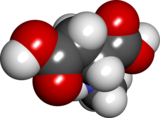
Back N-متیل-D-آسپارتیک اسید AZB Àcid N-metil-D-aspàrtic Catalan NMDA Czech N-Methyl-D-aspartatsyre Danish NMDAR Spanish N-متیل-D-آسپارتیک اسید Persian NMDA Finnish NMDA French Ácido N-metil-D-aspártico Galician NMDA Hungarian
This article needs additional citations for verification. (March 2021) |

| |

| |

| |
| Names | |
|---|---|
| IUPAC name
N-Methyl-D-aspartic acid
| |
| Systematic IUPAC name
(2R)-2-(Methylamino)butanedioic acid[1] | |
| Other names
N-Methylaspartate; N-Methyl-D-aspartate; NMDA
| |
| Identifiers | |
3D model (JSmol)
|
|
| 1724431 | |
| ChEBI | |
| ChEMBL | |
| ChemSpider | |
| KEGG | |
| MeSH | N-Methylaspartate |
PubChem CID
|
|
| RTECS number |
|
| UNII | |
CompTox Dashboard (EPA)
|
|
| |
| |
| Properties | |
| C5H9NO4 | |
| Molar mass | 147.130 g·mol−1 |
| Appearance | White, opaque crystals |
| Odor | Odorless |
| Melting point | 189 to 190 °C (372 to 374 °F; 462 to 463 K) |
| log P | 1.39 |
| Acidity (pKa) | 2.206 |
| Basicity (pKb) | 11.791 |
| Hazards | |
| Lethal dose or concentration (LD, LC): | |
LD50 (median dose)
|
137 mg kg−1 (intraperitoneal, mouse) |
| Related compounds | |
Related amino acid derivatives
|
|
Related compounds
|
Dimethylacetamide |
Except where otherwise noted, data are given for materials in their standard state (at 25 °C [77 °F], 100 kPa).
| |
N-methyl-D-aspartic acid or N-methyl-D-aspartate (NMDA) is an amino acid derivative that acts as a specific agonist at the NMDA receptor mimicking the action of glutamate, the neurotransmitter which normally acts at that receptor. Unlike glutamate, NMDA only binds to and regulates the NMDA receptor and has no effect on other glutamate receptors (such as those for AMPA and kainate). NMDA receptors are particularly important when they become overactive during, for example, withdrawal from alcohol as this causes symptoms such as agitation and, sometimes, epileptiform seizures.[citation needed]
- ^ "N-Methylaspartate - Compound Summary". PubChem Compound. USA: National Center for Biotechnology Information. 24 June 2005. Identification. Retrieved 9 January 2012.
© MMXXIII Rich X Search. We shall prevail. All rights reserved. Rich X Search